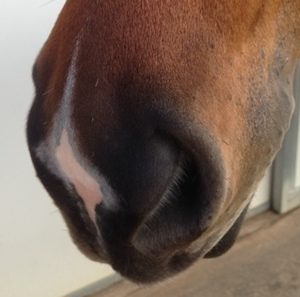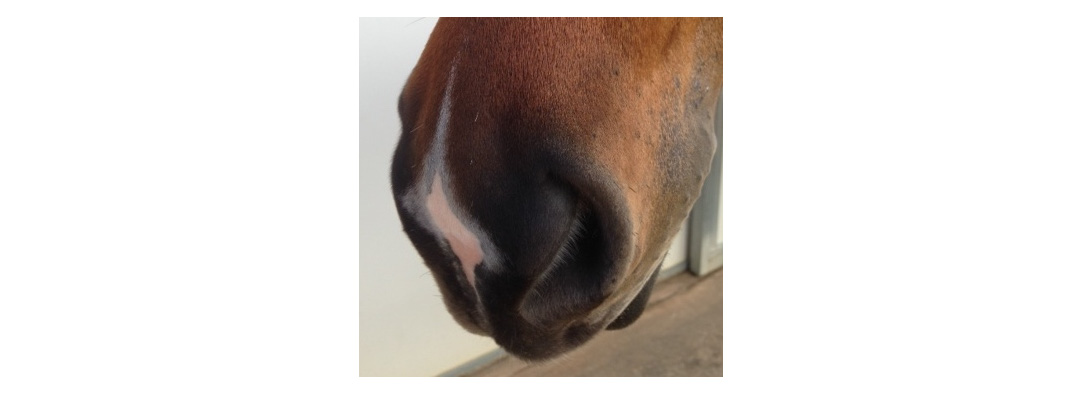How to Help the Horse with Heaves
by Eleanor Blazer

Do you know the normal resting respiration rate of your horse? Knowledge of this easy-to-monitor vital sign could help you detect the start of equine asthma, better known as “heaves”. Early detection will enable you and your veterinarian to start a plan to battle this potentially debilitating disease.
The normal resting respiration rate of a mature healthy horse is between 8 and 20 breaths per minute, with 16 cycles per minute being the average. Because of the wide range, horse owners should record what is normal for each individual horse. The respiration rate is the number of times a horse inhales and exhales each minute. (That’s two actions for one count.)
During intense exercise in high temperatures or high humidity, the respiration rate could increase as high as 120 cycles per minute. The rate should drop to 40-50 breaths per minute in about 15 minutes when exertion is curtailed. Recovery time is an important indicator of the horse’s condition.
The respiration rate will climb with stress, excitement or exercise. When checking this vital sign, the horse must be comfortable and calm.
The best way to determine the rate is to place your hand on the side of the rib cage and count the number of breaths taken in one minute. Use a watch with a second hand or the timer on your smartphone. Another way to find the rate is to stand back from the horse and count the in and out motions of the rib cage, or the opening and closing of the nostrils. Count and time in the same manner; two actions for one count.
If you have a stethoscope, place it on the horse’s windpipe to listen to his breathing. If you hear strange sounds—something which sounds restricted, rough or raspy—the windpipe may be blocked by mucous or the horse may have allergies or heaves. Have the horse examined by a veterinarian.
Other signs of equine asthma are coughing, a thick discharge from your horse’s nostrils, and the use of abdominal muscles to expel or push the air out of the lungs during the exhalation cycle of breathing. As the disease progresses weight loss will develop as the horse burns calories in the struggle to breathe.
To control the symptoms and slow the progression of the disease, management of the horse is critical. Equine asthma is also called recurrent airway obstruction (RAO), so named because the disease fluctuates with environmental changes. Heaves are caused by allergies to dust, mold and pollen. Control and eliminate the irritating triggers, and the horse improves, but then recurs when the contaminants reappear.
Steps to take when managing a horse with RAO are:
* Do not stall horses; allow them to be outside as much as possible
* Horses with allergies to pollen should not have access to pasture
* Hay should be soaked, and not fed in enclosed feeders
* Severely affected horses should be fed pelleted/cubed forage or a complete feed (no hay)
* Avoid feeding round bales
* Do not feed dusty or moldy feed/hay
* Do not store hay above the stalls as dust will filter down
* When sweeping the barn, horses should be removed
* Bedding should be low-dust; no straw or fine shavings; bedding may need to be wetted to control dust.
A recent study conducted by Perdue University College of Veterinary Medicine showed omega-3 fatty acid supplements helped horses breathe better, and coughing improved within two to three weeks. These horses were also put on a complete pelleted diet, with no access to hay.
Drug therapy is available to help the horse with heaves. Drugs should not be used as a substitute for managing the environment in which the horse is housed, but used in conjunction with a change in management. Many horses will improve without drugs, if their environment is changed for the better.

These are the drugs your veterinarian may recommend: corticosteroids, bronchodilators or an antihistamines/decongestant combination.
Corticosteroids are produced naturally in the body, but synthetic (man-made) corticosteroids are used to fight inflammation and suppress the immune response to the allergen (decreasing the symptoms). Adverse side effects (suppression of the immune system, ulcers, laminitis and adrenal gland problems) so limit long-term use. Side effects are decreased if the drug is administered via inhalation. When stopping the use of a corticosteroid the drug must be decreased gradually to allow the body to start re-making corticosteroids on its own.
Bronchodilators – these drugs dilate and relax the airways into the lungs. Effectiveness is quick, making bronchodilators excellent for treating a horse that is in an acute (active) heaves attack. Bronchodilators do not help with the mucus or inflammation. Available in oral and aerosolized for inhalation.
Antihistamines/decongestants – treatments which contain an antihistamine and a decongestant are available over-the-counter (OTC) in granular form. The antihistamine component helps block or reduce the body’s respond to an allergen. The decongestant in the OTC product helps break down the mucous and make it easier for the horse to clear the mucous from the lungs. Pseudoephedrine is a common decongestant used in the formulations.
Along with changing the environment and using drugs to give the horse some relief during attacks, the diet must be addressed. Eliminating poor quality hay that is dusty and moldy is the first step. Providing a balanced diet, which supplies the energy needed by the horse to maintain body weight, is the next step. The use of senior and complete feeds fill both of these needs – providing a dust-free, but balanced diet. Follow the feeding directions on the product and consult your veterinarian.
The care of a horse with heaves is not easy, but with vigilance and effort his life can be less stressful.
Copyright @ 2016
* Take the online course “Horse Health and Disease”. Earn certification or work toward a Bachelor of Science degree in Equine Studies. All courses are online. Go to www.horsecoursesonline.com for more information.
Originally Published January 2017 Issue

Eleanor Blazer was raised training and caring for horses. She learned to ride and care for the horses her family bought and sold. Many of these horses required improved nutrition when they arrived for training. Eleanor’s experience and research has benefited both horses and horse lovers in the field of equine nutrition. An equine nutrition consultant, based in Bulverde, Texas, she keeps busy doing equine nutrition consultations, conducting seminars, and speaking to youth groups about horse care and nutrition. Eleanor is the author of the syndicated column The Way of Horses. She has more than 20 years experience helping and being a mentor to those wanting to know how to provide the very best care and nutrition for our special friend – the horse.





